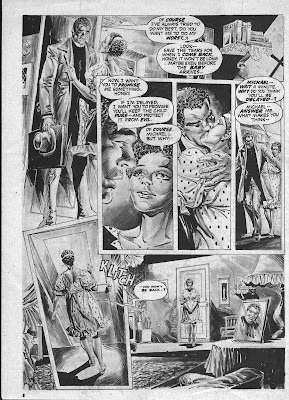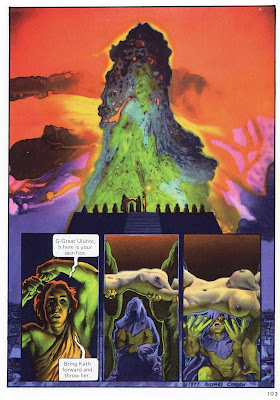Book Review: 'Death Cloud' by Michael Mannion
3 / 5 Stars
'Death Cloud' was first published in the UK in 1976; this New English Library paperback version (160 pp) was released in September 1977, and features a memorable cover illustration by Tim White:
The novel is set in the mid-70s in the small college town of Dorchester, Pennsylvania, not far from Pittsburgh. Newlyweds Paul McLain and his wife Denise have moved to Dorchester in order for Paul to begin graduate school at the University located there.
Paul and his wife enjoy the rural character of the town and the abundant Fall foliage. But as they settle into life as a married couple, they begin to notice some unpleasant aspects of life in Dorchester.....the nasty smell in the air generated by the factories, and, in the outskirts of town, a strange black cloud that hangs low in the air, bringing with it a dark fog and temperatures noticeably warmer than the ambient air.
When an elderly neighbor nearly dies from a respiratory attack brought on by the appearance of the black fog, Paul decides to team up with Kevin Campbell, a young faculty member and environmental scientist, to investigate the nature of the black cloud. This soon brings them into conflict with the powers that be in Dorchester: wealthy industrialists and businessmen who stand to lose their profits should action be taken to curtail factory output to reduce pollution.
Disheartened by the hostility of the town fathers, Paul McLain resolves to abandon his scientific inquiries into the black cloud and focus on finishing his graduate studies. But he finds the threat of the cloud is impossible to ignore once its thick, choking fogs begin to smother Dorchester with increasing regularity........and soon, even the healthiest of the town's residents will come to know the special fear that comes with the arrival of the Death Cloud....
'Death Cloud' is one of those quintessential New English Library volumes from the 70s that takes an interesting premise, and does just enough with it to get by.
Much of Michael Mannion's narrative is taken up with exploring the emotional and psychological travails of Paul McLain and his wife, who fears that his efforts to alert the community to the dangers of pollution will lead to his expulsion from the University. There are frequent scenes of marital arguments, tearful make-up sessions, followed in due course by another round of arguments.
The eponymous Cloud is more of an abstract, vaguely realized plot device driving the actions of the characters, than a scientific exploration of environmental disaster. This tends to make the middle sections of the novel slow going, even given the book's comparatively short length.
'Death Cloud' does partly redeem itself in the closing chapters, as calamity approaches Dorchester and Paul McLain and his fellow activists find themselves engaged in desperate struggle to warn the town and its skeptical leaders. Mannion's handling of the plot is at its best in these closing chapters, which are modeled to some extent on the real life Eco-disaster that took place in the town of Donora, Pennsylvania, in 1948.
Street scene in Donora, Pennsylvania during the smog disaster of October 1948
The verdict ? As a 70s Eco-disaster novel, 'Death Cloud' is passable, if not particularly memorable. It's worth picking up if you happen to see a copy on the shelves of your favorite used bookstore, but I can't recommend making a special effort to search it out.




























































































